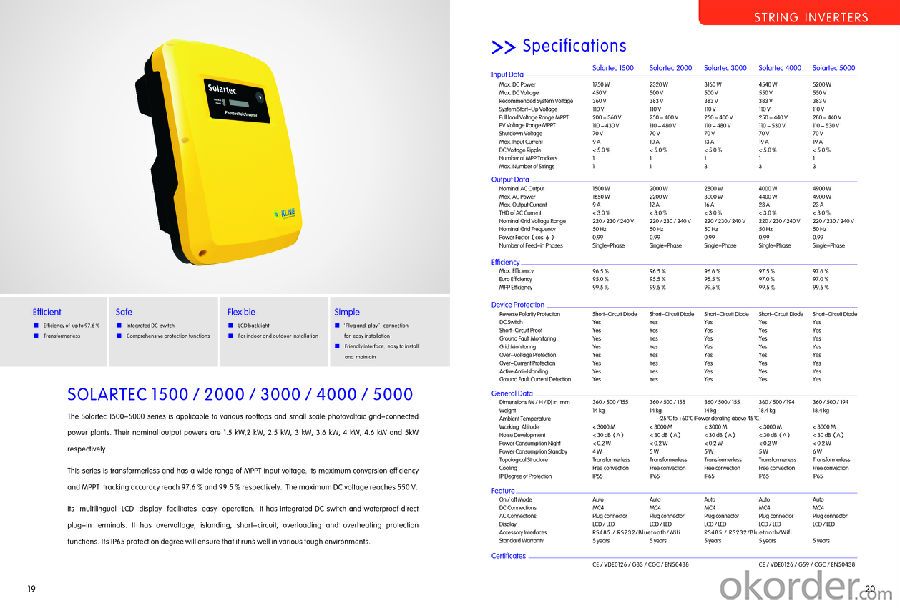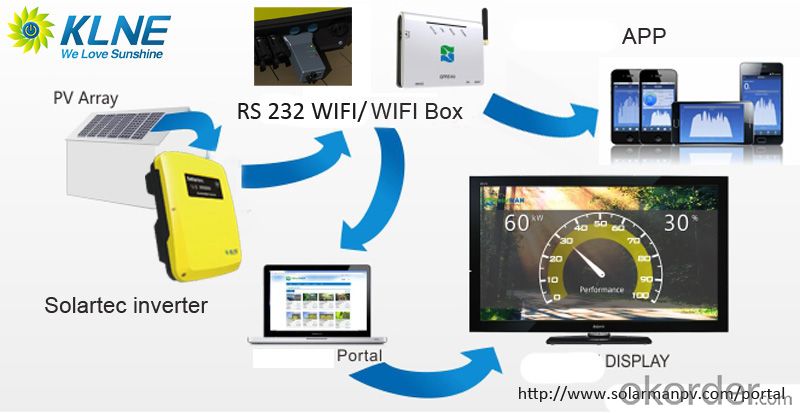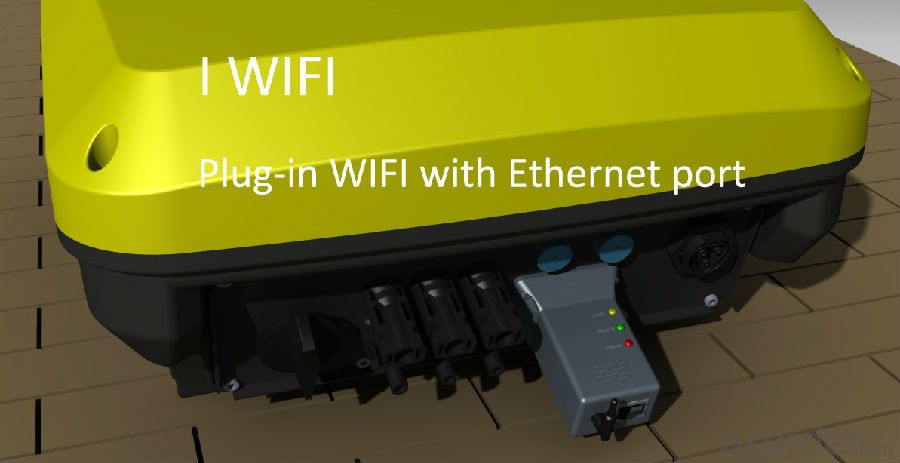Solartec 4600 KLNE on grid inverter with WIFI
- Loading Port:
- Shanghai
- Payment Terms:
- TT OR LC
- Min Order Qty:
- -
- Supply Capability:
- 10000 set/month
OKorder Service Pledge
Quality Product, Order Online Tracking, Timely Delivery
OKorder Financial Service
Credit Rating, Credit Services, Credit Purchasing
You Might Also Like
Solartec 1500,2000,2500,3000,3600,4000,4600,5000
1MPPT, single phase
IP 65
New mold with Pure thick aluminum crust.
Efficient
■ Efficiency of up to 97.6 %
■ TransformerlessSafe
■ Integrated DC switch
■ Comprehensive protection functionsFlexible
■ LCD backlight
■ For indoor and outdoor installationSimple
■ ‘Plug and play’connection for easy installation
■ Friendly interface, easy to install and maintain


- Q:Can a solar inverter be used with a solar-powered security system?
- Yes, a solar inverter can be used with a solar-powered security system. A solar inverter is responsible for converting the direct current (DC) generated by solar panels into alternating current (AC) that can be used to power electrical devices. In the context of a solar-powered security system, a solar inverter is essential for converting the energy generated by solar panels into usable power to operate the security system's components, such as cameras, sensors, alarms, or communication devices. Therefore, integrating a solar inverter is crucial to ensure the functionality of a solar-powered security system.
- Q:What is the role of a solar inverter in fault ride-through capability?
- The role of a solar inverter in fault ride-through capability is to ensure that the solar power system remains connected to the grid during grid faults or disturbances. The inverter is responsible for detecting the fault and adjusting its operating parameters to ride through the fault without disconnecting from the grid. This capability helps maintain a stable and reliable power supply, as the solar inverter can continue to inject power into the grid even during temporary faults, reducing the impact on the overall system stability.
- Q:What are the safety measures to consider when installing a solar inverter?
- When installing a solar inverter, there are several important safety measures to consider. Firstly, it is crucial to turn off the main electrical supply before beginning any installation work. This will prevent the risk of electric shock or injury. Additionally, it is important to wear appropriate personal protective equipment (PPE) such as gloves, safety glasses, and non-slip footwear to ensure personal safety during the installation process. Another safety measure is to ensure proper grounding of the solar inverter system to prevent electrical faults and potential fire hazards. Furthermore, it is essential to follow the manufacturer's instructions and guidelines for installation to ensure proper wiring and avoid any potential electrical hazards. Regular maintenance and inspections should also be conducted to identify and address any potential safety issues or malfunctions. Overall, prioritizing safety measures during the installation of a solar inverter is crucial to minimize risks and ensure the safe and efficient operation of the system.
- Q:Can a solar inverter be used with solar-powered desalination systems?
- Yes, a solar inverter can be used with solar-powered desalination systems. A solar inverter is essential in converting the direct current (DC) power generated by solar panels into alternating current (AC) power that can be used to operate the desalination system. This allows for the efficient utilization of solar energy for powering the desalination process.
- Q:What is the role of a solar inverter in a net metering system?
- The role of a solar inverter in a net metering system is to convert the direct current (DC) electricity generated by solar panels into alternating current (AC) electricity that can be used by the grid or consumed in the building. It also ensures that any excess electricity produced by the solar panels is fed back into the grid, allowing the system owner to receive credits or compensation for the surplus energy.
- Q:What certifications should a solar inverter have?
- A solar inverter should have certifications such as UL 1741, IEC 62109, and IEEE 1547 to ensure its compliance with safety standards, grid interconnection requirements, and performance reliability.
- Q:Can a solar inverter be used with a solar-powered pool heating system?
- Yes, a solar inverter can be used with a solar-powered pool heating system. A solar inverter is responsible for converting the DC (direct current) power generated by solar panels into AC (alternating current) power that can be used by household appliances or fed back into the electrical grid. In the case of a solar-powered pool heating system, the solar panels generate DC power, which is then converted by the inverter into AC power to operate the pool heating system.
- Q:What are the key differences between a central inverter and a string inverter?
- The key differences between a central inverter and a string inverter lie in their design and functionality. A central inverter is a larger unit that is typically installed at a centralized location, such as a utility room, and is connected to multiple strings of solar panels. It converts the DC (direct current) electricity generated by the solar panels into AC (alternating current) electricity that can be used to power appliances or fed back into the grid. Central inverters are more suitable for larger installations, as they can handle higher power capacities and are more efficient at converting DC to AC. On the other hand, a string inverter is a smaller unit that is usually installed near the solar panels and is connected to each individual string of solar panels. It converts the DC electricity from each string into AC electricity. String inverters are more commonly used in smaller residential or commercial installations, as they offer more flexibility in panel arrangement and monitoring. They also allow for individual optimization and monitoring of each string, which can be beneficial in cases where panels may be shaded or have different orientations. In summary, while central inverters are better suited for larger installations and offer higher efficiency, string inverters provide more flexibility and individual optimization options for smaller installations.
- Q:Can a solar inverter be used with different types of grid support functions?
- Yes, a solar inverter can be used with different types of grid support functions. Solar inverters are designed to convert the direct current (DC) produced by solar panels into alternating current (AC) that can be fed into the electrical grid. They can be equipped with various grid support functions like reactive power control, voltage regulation, and frequency control. These functions enable solar inverters to adapt to different grid requirements and contribute to grid stability and reliability.
- Q:Can a solar inverter convert DC power to AC power during a power outage?
- No, a solar inverter cannot convert DC power to AC power during a power outage. Solar inverters rely on the grid for synchronization and voltage reference, so when there is a power outage, the inverter automatically shuts down to prevent back-feeding electricity into the grid and endangering utility workers.
1. Manufacturer Overview |
|
|---|---|
| Location | |
| Year Established | |
| Annual Output Value | |
| Main Markets | |
| Company Certifications | |
2. Manufacturer Certificates |
|
|---|---|
| a) Certification Name | |
| Range | |
| Reference | |
| Validity Period | |
3. Manufacturer Capability |
|
|---|---|
| a)Trade Capacity | |
| Nearest Port | |
| Export Percentage | |
| No.of Employees in Trade Department | |
| Language Spoken: | |
| b)Factory Information | |
| Factory Size: | |
| No. of Production Lines | |
| Contract Manufacturing | |
| Product Price Range | |
Send your message to us
Solartec 4600 KLNE on grid inverter with WIFI
- Loading Port:
- Shanghai
- Payment Terms:
- TT OR LC
- Min Order Qty:
- -
- Supply Capability:
- 10000 set/month
OKorder Service Pledge
Quality Product, Order Online Tracking, Timely Delivery
OKorder Financial Service
Credit Rating, Credit Services, Credit Purchasing
Similar products
New products
Hot products
Hot Searches
Related keywords






























